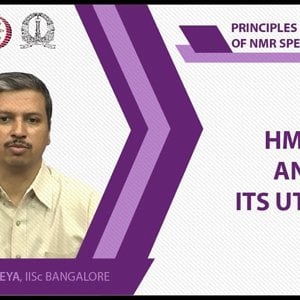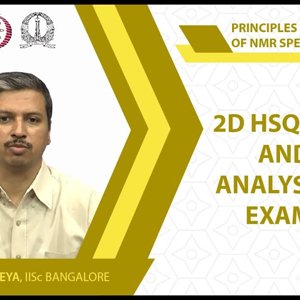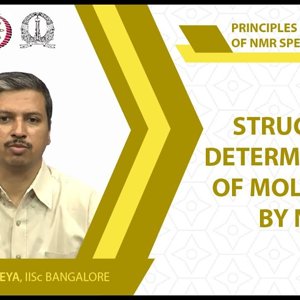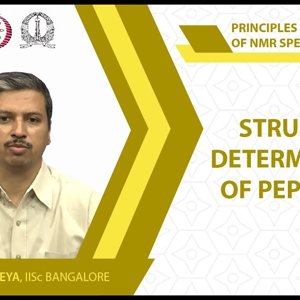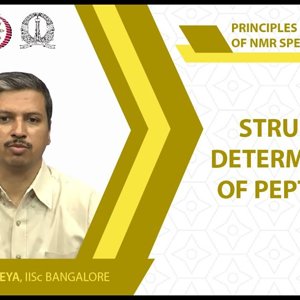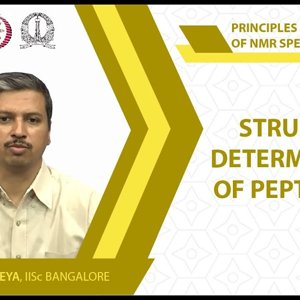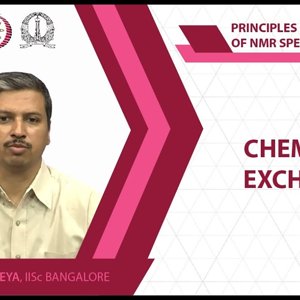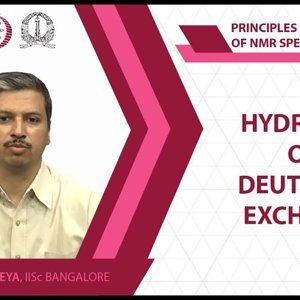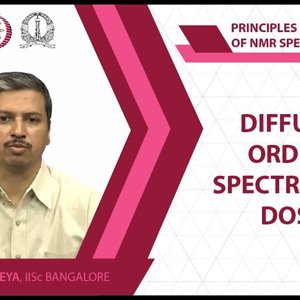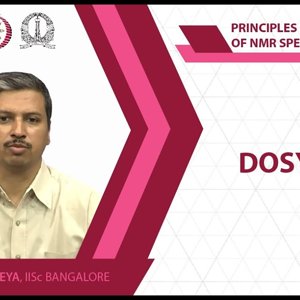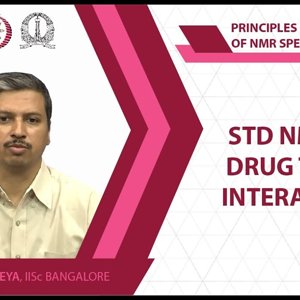Nmr Definition and 181 Threads
-
NMR Spectroscopy by Prof. Hanudatta S. Atreya (NPTEL):- Lecture :30 HMBC and its utility
All copyright strictly reserved to Prof. Atreya and NPTEL, Govt. of India. COURSE WEBSITE: https://www.youtube.com/redirect?redir_token=J3W-BvVF9P_QSjr1ljVg8I2O_Bl8MTUyNDU4NDYyMEAxNTI0NDk4MjIw&event=playlist_description&q=http%3A%2F%2Fwww.nptel.ac.in%2Fcourses%2F104108078%2F10- Wrichik Basu
- Media item
- nmr nuclear magnetic resonance spectrocopy
- Comments: 0
- Category: Chemistry
-
NMR Spectroscopy by Prof. Hanudatta S. Atreya (NPTEL):- Lecture 31: 2D HSQC TOCSY and its analysis with examples
All copyright strictly reserved to Prof. Atreya and NPTEL, Govt. of India. COURSE WEBSITE: https://www.youtube.com/redirect?redir_token=J3W-BvVF9P_QSjr1ljVg8I2O_Bl8MTUyNDU4NDYyMEAxNTI0NDk4MjIw&event=playlist_description&q=http%3A%2F%2Fwww.nptel.ac.in%2Fcourses%2F104108078%2F10- Wrichik Basu
- Media item
- nmr nuclear magnetic resonance spectrocopy
- Comments: 0
- Category: Chemistry
-
NMR Spectroscopy by Prof. Hanudatta S. Atreya (NPTEL):- Lecture 32: Structure determination of molecules by NMR
All copyright strictly reserved to Prof. Atreya and NPTEL, Govt. of India. COURSE WEBSITE: https://www.youtube.com/redirect?redir_token=J3W-BvVF9P_QSjr1ljVg8I2O_Bl8MTUyNDU4NDYyMEAxNTI0NDk4MjIw&event=playlist_description&q=http%3A%2F%2Fwww.nptel.ac.in%2Fcourses%2F104108078%2F10- Wrichik Basu
- Media item
- nmr nuclear magnetic resonance spectrocopy
- Comments: 0
- Category: Chemistry
-
NMR Spectroscopy by Prof. Hanudatta S. Atreya (NPTEL):- Lecture 33: Structure determination of peptides I
All copyright strictly reserved to Prof. Atreya and NPTEL, Govt. of India. COURSE WEBSITE: https://www.youtube.com/redirect?redir_token=J3W-BvVF9P_QSjr1ljVg8I2O_Bl8MTUyNDU4NDYyMEAxNTI0NDk4MjIw&event=playlist_description&q=http%3A%2F%2Fwww.nptel.ac.in%2Fcourses%2F104108078%2F10- Wrichik Basu
- Media item
- nmr nuclear magnetic resonance spectrocopy
- Comments: 0
- Category: Chemistry
-
NMR Spectroscopy by Prof. Hanudatta S. Atreya (NPTEL):- Lecture 34: Structure determination of peptides II
All copyright strictly reserved to Prof. Atreya and NPTEL, Govt. of India. COURSE WEBSITE: https://www.youtube.com/redirect?redir_token=J3W-BvVF9P_QSjr1ljVg8I2O_Bl8MTUyNDU4NDYyMEAxNTI0NDk4MjIw&event=playlist_description&q=http%3A%2F%2Fwww.nptel.ac.in%2Fcourses%2F104108078%2F10- Wrichik Basu
- Media item
- nmr nuclear magnetic resonance spectrocopy
- Comments: 0
- Category: Chemistry
-
NMR Spectroscopy by Prof. Hanudatta S. Atreya (NPTEL):- Lecture 35: Structure determination of peptides III
All copyright strictly reserved to Prof. Atreya and NPTEL, Govt. of India. COURSE WEBSITE: https://www.youtube.com/redirect?redir_token=J3W-BvVF9P_QSjr1ljVg8I2O_Bl8MTUyNDU4NDYyMEAxNTI0NDk4MjIw&event=playlist_description&q=http%3A%2F%2Fwww.nptel.ac.in%2Fcourses%2F104108078%2F10- Wrichik Basu
- Media item
- nmr nuclear magnetic resonance spectrocopy
- Comments: 0
- Category: Chemistry
-
NMR Spectroscopy by Prof. Hanudatta S. Atreya (NPTEL):- Lecture 36: Chemical exchange
All copyright strictly reserved to Prof. Atreya and NPTEL, Govt. of India. COURSE WEBSITE: https://www.youtube.com/redirect?redir_token=J3W-BvVF9P_QSjr1ljVg8I2O_Bl8MTUyNDU4NDYyMEAxNTI0NDk4MjIw&event=playlist_description&q=http%3A%2F%2Fwww.nptel.ac.in%2Fcourses%2F104108078%2F10- Wrichik Basu
- Media item
- nmr nuclear magnetic resonance spectrocopy
- Comments: 0
- Category: Chemistry
-
NMR Spectroscopy by Prof. Hanudatta S. Atreya (NPTEL):- Lecture 37: Hydrogen or deuterium exchange
All copyright strictly reserved to Prof. Atreya and NPTEL, Govt. of India. COURSE WEBSITE: https://www.youtube.com/redirect?redir_token=J3W-BvVF9P_QSjr1ljVg8I2O_Bl8MTUyNDU4NDYyMEAxNTI0NDk4MjIw&event=playlist_description&q=http%3A%2F%2Fwww.nptel.ac.in%2Fcourses%2F104108078%2F10- Wrichik Basu
- Media item
- nmr nuclear magnetic resonance spectrocopy
- Comments: 0
- Category: Chemistry
-
NMR Spectroscopy by Prof. Hanudatta S. Atreya (NPTEL):- Lecture 38: Diffusion ordered spectroscopy DOSY I
All copyright strictly reserved to Prof. Atreya and NPTEL, Govt. of India. COURSE WEBSITE: https://www.youtube.com/redirect?redir_token=J3W-BvVF9P_QSjr1ljVg8I2O_Bl8MTUyNDU4NDYyMEAxNTI0NDk4MjIw&event=playlist_description&q=http%3A%2F%2Fwww.nptel.ac.in%2Fcourses%2F104108078%2F10- Wrichik Basu
- Media item
- nmr nuclear magnetic resonance spectrocopy
- Comments: 0
- Category: Chemistry
-
NMR Spectroscopy by Prof. Hanudatta S. Atreya (NPTEL):- Lecture 39: DOSY II
All copyright strictly reserved to Prof. Atreya and NPTEL, Govt. of India. COURSE WEBSITE: https://www.youtube.com/redirect?redir_token=J3W-BvVF9P_QSjr1ljVg8I2O_Bl8MTUyNDU4NDYyMEAxNTI0NDk4MjIw&event=playlist_description&q=http%3A%2F%2Fwww.nptel.ac.in%2Fcourses%2F104108078%2F10- Wrichik Basu
- Media item
- nmr nuclear magnetic resonance spectrocopy
- Comments: 0
- Category: Chemistry
-
NMR Spectroscopy by Prof. Hanudatta S. Atreya (NPTEL):- Lecture 40: STD NMR for drug target interactions
All copyright strictly reserved to Prof. Atreya and NPTEL, Govt. of India. COURSE WEBSITE: https://www.youtube.com/redirect?redir_token=J3W-BvVF9P_QSjr1ljVg8I2O_Bl8MTUyNDU4NDYyMEAxNTI0NDk4MjIw&event=playlist_description&q=http%3A%2F%2Fwww.nptel.ac.in%2Fcourses%2F104108078%2F10- Wrichik Basu
- Media item
- nmr nuclear magnetic resonance spectrocopy
- Comments: 0
- Category: Chemistry
-
D
Finding the magnetization in nuclear magnetic resonance
Homework Statement J-coupling term between two spins is HJ = ħJ/4 σz(1) σz(2) In the measured magnetization spectrum of the spins, this leads to the splitting of the individual spin lines by frequency J, which we’ll now derive. We can write the magnetization of spin 1 as: <M1(t)> =...- David DCruz
- Thread
- Magnetic Magnetic resonance Magnetization Nmr Nuclear Nuclear magnetic resonance Quantum computation Quantum information Resonance
- Replies: 3
- Forum: Advanced Physics Homework Help
-

Undergrad Can i cause NMR with a simple slayer exiter (Tesla coil)?
hello guys i saw a slayer exciter circuit , witch is the crude more simpler version of the tesla coil and i made it , it works quite well but i have some questions. some questions : 1 - how strong is the magnetic field caused by this tesla coil ? it can ionize neon gas , or argon ? 2 - i...- patric44
- Thread
- Cause Coil Nmr Nuclear magnetic resonance Tesla coil Zeeman effect
- Replies: 7
- Forum: Electromagnetism
-

How is RF in-homogeneity in NMR addressed?
IN NMR, the sample is placed in the probe and is excited by the coil using RF fields. But, errors creep in due to the inhomogeneous nature of the B1 field and also the errors in the static magnetic field(which are taken care of using shim coils). In some of the research papers I read, they just... -

Graduate Best coil design for homogeneus NMR RF pulse on liquid discs
Hi there, we have a NMR spectrometer equipped with a standard bore 54mm cryomagnet working at 14.1 T (600 MHz Larmor Frequency) produced by Oxford. I would implement a special probe capable of generating a RF pulse and reading a NMR answer from a sample that is not standard for such...- _maxim_
- Thread
- Coil Design Liquid Nmr Pulse Rf Spectroscopy
- Replies: 13
- Forum: Atomic and Condensed Matter
-
E
NMR Diastereotopic Proton Splitting
This is one of those questions that probably has a very simple answer, but I can't find it anywhere, and as much as I think about it, the more confused I get. Can diastererotopic protons have different number of split peaks in their overall signal like on a CH2R group, for example, one proton... -
A
Graduate NMR Experiments: Why Do I Need a Broadband Probe Head?
Hello I have to do an nmr experiement. Why do i need a broadband probe head? I have a magnet with 2 tesla. and modulation coils on it with a frequency of 50hz. For example i have a resonance frequency at 50mhz. i hope you can pelp me.- annaline19
- Thread
- Experiments Head Nmr Probe
- Replies: 3
- Forum: Other Physics Topics
-

Undergrad NMR: RF-pulse response away from equilibrium
Hello everybody, I've got a gap in my understanding regarding NMR systems, and I hope you can help: if the magnetisation of a proton is M0 in the Mz direction initially, a 90ox-RF-pulse will change the magnetisation to M0 in the My direction immediately after the pulse. But what happens when a...- Nogniks
- Thread
- Equilibrium Nmr Response
- Replies: 3
- Forum: Quantum Physics
-
J
Undergrad Nitrogen-Vacancy centres in Diamond for NMR spectroscopy
Hello, I have been looking into NV in diamond and how it can be used for nanoscale magnetometry, and was wondering if anyone could help explain how it works or link to a paper that does. Is it just a spin 1 state (splits to 3 levels) that undergoes NMR or is there something else happening? I'm...- Jon.G
- Thread
- Diamond Nmr Spectroscopy
- Replies: 2
- Forum: Atomic and Condensed Matter
-

NMR spectroscopy, ligand's influence
Hi, i have been wondering about the influence of the ligands on metal NMR shifts, for complexes with metal like Pd, the ligands are 2 amine ligands, and they have also two chlorides in structure, cis or trans geometry. In DMF, when comparing the difference between the chemical shifts of the...- KarolinaPL
- Thread
- Nmr Spectroscopy
- Replies: 1
- Forum: Chemistry
-
M
Quantum NMR or Medical Imaging (Advanced )
Suppose I want to learn about MRI. Some of the introductory treatments I have seen aimed at engineers or imaging professionals may not assume much more than sophomore level physics competency. I know some advanced QM and statistical physics so I am wondering about the existence or value of a...- MisterX
- Thread
- advanced Imaging Medical Medical imaging Mri Nmr
- Replies: 2
- Forum: Science and Math Textbooks
-
H
Undergrad Solid State NMR and X-ray Crystallography resources
Hello, I need to learn how Solid State NMR and X-ray Crystallography work (theory and practical application). I'm primary interested in how those experimental techniques are used to determine molecular structures. I'm an undergrad physics student and I need this to pass my final exam. So if some...- hbarSquared
- Thread
- Crystallography Nmr Resources Solid Solid state State X-ray X-ray crystallography
- Replies: 2
- Forum: Atomic and Condensed Matter
-

Will Cycloalkanes Always Show One Peak in Hydrogen-1 NMR?
Will members of the cycloalkane homologous series only ever show one peak in Hydrogen - 1 NMR spectroscopy due to the symmetry in the molecules?- Saracen Rue
- Thread
- Nmr
- Replies: 3
- Forum: Chemistry
-

Ordering Carbonyl Group Wavenumbers in NMR
Homework Statement I want to put these in order of increasing wavenumber for the absorptions of the carbonyl group in an nmr spectrum Homework EquationsThe Attempt at a Solution I know that the third one is the highest, the NH ketoamine is the lowest and last one is the second lowest but I'm...- Amy B
- Thread
- Group Ir spectroscopy Nmr
- Replies: 1
- Forum: Biology and Chemistry Homework Help
-

Will Hydrogens Be Exchanged for Deuterium in D2O NMR Experiments?
Homework Statement In a D2O experiment, will any of the Hydrogens be exchanged for D? Homework EquationsThe Attempt at a Solution It appears that it has no OH or NH hydrogens which will exchange but it does Have a carbonyl group with alpha hydrogens so I don't know if they might be exchanged...- Amy B
- Thread
- Exchange Nmr
- Replies: 1
- Forum: Biology and Chemistry Homework Help
-

Why do deshielded protons require more energy in NMR spectroscopy?
As you move to the left in the NMR spectrum, the protons become more deshielded. So why is it that they require MORE energy to change their spin? If they don't require more energy, then why is the left side labeled as high frequency? Thanks. -
F
NMR Signals & Peaks of Di-Substituted Benzene Rings
How many NMR signals and peaks will there be for a di-substituted benzene ring and why? The ring has one CH3 and and a Cl ortho to the CH3. (This isn't a homework problem but I am running into same issue whenever I encounter rings wrt NMR) i am specifically confused as to how to apply...- FTNMR
- Thread
- Benzene Nmr Rings Signals
- Replies: 5
- Forum: Biology and Chemistry Homework Help
-
S
Question about tenting in H NMR
If tenting is observed in a 1H NMR spectrum, I understand what causes the tenting to occur, but can the presence of tenting allow anything be deduced about the proximity or arrangement of the protons responsible? -
X
Undergrad Could NMR be applied for other elements besides Hydrogen?
Most books discribe NMR as a diagnotic technique for Hydrogen and its isotopes. Could Nuclear Magnetic Resonance Spectroscopy be applied for other elements with odd atomic number besides H? If so, what is the major challenge for a multi-element scanning? -
B
Graduate Why does spin-spin coupling cause splitting in NMR spectroscopy?
Hi. I was wondering if you could please help me understand something about NMR spectroscopy (MRS). I know that the chemical shift (Hz) of a particular chemical will vary with B0. As I understand (although this may be wrong) ppm is frequency independent so the peaks should always be in the same...- BobP
- Thread
- Nmr Spectroscopy
- Replies: 13
- Forum: Classical Physics
-

How much are machine learning and NMR related in medical imaging?
Hi everyone. By reading stuff on the Internet, I found many times the correlation between machine learning and NMR, or, better, algorithms that are implemented for that kind of technology( The same goes for PET, or CT scans. The thing I want to ask is, how much do you think that the two things...- Domenico94
- Thread
- Artificial intelligence Machine Machine learning Medicine Mri Nmr X rays
- Replies: 4
- Forum: Programming and Computer Science
-

Graduate Why Don't NMR Magnet Designs Utilize the Fourth Maxwell Equation?
Hi everyone...I'm just looking nmr schemes, and magnets, and, at the same time, studying Physics II and electromagnetic fields at my faculty of electronics engineering. I know this may sound like a "dumb" question, and I don't want to sound like councited or similar stuff, but I was just asking...- Domenico94
- Thread
- Cern Magnets Nmr Physics Physics ii Resonance Science
- Replies: 18
- Forum: Electromagnetism
-
L
Calculating Chemical Shift: How do magnetic fields affect NMR frequencies?
Homework Statement In an NMR spectrum a CH2 group has a peak centred at 9.81 ppm. What is the shift in Larmor frequency of the protons from that of an unshielded proton if the spectrometer magnetic field is 9.4 T? The magnetogyric ratio of an unshielded proton is γH = 26.75 × 107 rad s-1T-1 2...- Lily Wright
- Thread
- Frequency Nmr Shift
- Replies: 1
- Forum: Introductory Physics Homework Help
-
R
NMR: Why do "identical" protons not experience splitting?
Hey, I've been trying to figure out why a protons in identical environments will not undergo spin-spin splitting with one another. From what I understand splitting of a signal for a proton is due to the nucleus of another nearby either opposing the external magnetic field or acting in the same...- RKlintworth
- Thread
- Coupling Experience Nmr Proton Protons Splitting
- Replies: 5
- Forum: Chemistry
-

Organic Chemistry IR and NMR problem solving
Homework Statement I am trying to help my daughter determine the structure of this carbon compound. It has seven carbons, 14 hydrogens and one oxygen. The oxygen must be in a ketone group. Also each carbon is different (as indicated by the carbon 13 NMR). Homework Equations The Attempt...- montoyas7940
- Thread
- Chemistry Ir Nmr Organic Organic chemistry Problem solving
- Replies: 10
- Forum: Biology and Chemistry Homework Help
-
M
C-13 NMR Query in 2-Aminobutane: C3 Resonance
In 2-aminobutane, C3 resonates at lower field (ca 33ppm) compared to C1 (ca 23ppm). Is there a simple rationale for this? The extra inductive effect from C4 should increase electron density around C3 and so shift it upfield compared to C2? Any thoughts/answers greatly appreciated.- Miffymycat
- Thread
- Nmr
- Replies: 1
- Forum: Chemistry
-
A
Why Does the 31P NMR Spectrum of PF5 Depend on Temperature?
Why is the 31P NMR spectrum of PF5 temperature-dependent? PF5 has two different F environments (3 F, 2 F) and 19F has spin 1/2 so we'll be getting a quartet and a triplet with some overlap I guess. (Also not sure about peak intensities or if we can even predict them) So what changes, and how... -
B
Accurately and Quickly Interpreting NMR/IR Spectra
In examining the IR spectrum, I noted that there were peaks for CH2-x where x is bromine, methylene (2 peaks) and a peak corresponding to a methyl group; I concluded that I've synthesized n-bromobutane. Is the method I used to interpret my spectra sound? *CDCl3 was the IR solvent In addition...- biochem850
- Thread
- Instrumentation Nmr Organic Spectra Spectroscopy Synthesis
- Replies: 5
- Forum: Chemistry
-
K
Understand Splitting Patterns for NMR Molecules
I am struggling to understand how to determine splitting patterns for molecules. For example, (see attached) I was trying to determine the splitting pattern for CH2 in the molecule. On the right i believe n is equal to 1 and on the right it is equal to 3, but i am not sure if this is correct. A... -
C
NMR: How Does It Work? Confused by 2 Explanations
I've read two different explanations so I'm confused. The way I thought NMR works is that the protons spins align with the external magnetic field, then the RF radiation applied causes the spins to flip from -1/2 to 1/2, if the frequency of the radio waves are equal to the energy difference...- CrimpJiggler
- Thread
- Nmr Work
- Replies: 1
- Forum: Chemistry
-
B
Graduate Determining the value of B1 (or RF) in NMR
Hello If the time that takes for magnetization to rotate from its initial position (parallel with external magnetization) to x,y plane is given, how do we determine the value of B1? The formula I know: ω = γB1 = 2∏f1 lB1l < lBol angle between the magnetization and the external...- Bubble22
- Thread
- Nmr Rf Value
- Replies: 3
- Forum: High Energy, Nuclear, Particle Physics
-
B
Exponential Decay function in NMR
Homework Statement How many oscillations occur before Mxy decays to approximately 1/3 of its initial value, for a Larmor frequency of 100 MHz and T2 of 100ms?Homework Equations I was learning about how NMR works and about transverse relaxation. According to what I learned, we can express...- Bubble22
- Thread
- Decay Exponential Exponential decay Function Nmr
- Replies: 6
- Forum: Introductory Physics Homework Help
-
M
NMR - does rf cause transitions or simply rotate the magn vector?
Am I wrong in thinking that the rf radiation used in nmr is not "absorbed" by protons to cause transitions between spin states but rather it is only there to provide a magnetic field which can rotate the magnetisation vector away from the primary field? -
N
Undergrad NMR: Simple Question About Aligning w/ External Magnetic Field
Ok, well I'm not really sure if this is the right place to post this, but I have a simple question regarding nuclear magnetic resonance. I know that the "spin" axis of a proton will align along the external magnetic field. That's pretty simple. What I don't understand is the direction they...- nickypoo
- Thread
- Nmr
- Replies: 12
- Forum: Quantum Physics
-
C
Where Should I Zero the NMR Spectra of Dimethylacetamide in CDCl3?
Homework Statement I have a spectra of the NMR, I'm just confused on where to `zero' the spectra at? Homework Equations The Attempt at a Solution There are two peaks around zero in the spectra (one is bigger than the other but not by much). Also the two peaks are much much smaller than the...- Chickenpoxpie
- Thread
- Nmr
- Replies: 2
- Forum: Biology and Chemistry Homework Help
-
P
Reason for NMR results not being proportional with C-13
I am trying to figure out why unlike H-1, NMR output on C-13 is not proportional to types of carbons. Which is to say in a molecule with two CH3 and two CH2 The peaks for the related hydrogens would be one unit tall and 2/3 unit tall. Meanwhile the mentioned carbons would not by nessity have the...- paranoid times
- Thread
- Nmr Proportional Reason
- Replies: 3
- Forum: Chemistry
-
T
Graduate NMR Magnetic Moment: Understanding Bloch Equations and Relaxation Terms
Let M be the magnetic moment of a system. Below are the Bloch equations, including the relaxation terms. dM_x/dt=({\bf M} \times \gamma {\bf H_0})_x-M_x/T_2 dM_y/dt=({\bf M} \times \gamma {\bf H_0})_y-M_y/T_2 dM_z/dt=({\bf M} \times \gamma {\bf H_0})_z+(M_{\infty}-M_z)/T1 At t=0, {\bf...- the_kid
- Thread
- Magnetic Magnetic moment Moment Net Nmr
- Replies: 6
- Forum: Electromagnetism
-
M
Proton NMR: why does this appear as a multiplet?
Homework Statement It asks you to identify the shift and nature of the protons in the molecule. Picture: https://mailhost-6.tamu.edu/service/home/~/?auth=co&id=24393&part=2 Homework Equations none The Attempt at a Solution I cannot understand what makes C a multiplet...- Mitocarta
- Thread
- Nmr Proton
- Replies: 4
- Forum: Biology and Chemistry Homework Help
-
P
Graduate Fitting Pulsed NMR Data for Spin-Lattice Relaxation Time (T1)
Hello, I didn't know where else to post this so here it goes ... I have collected data from a pulsed NMR experiment to calculate the value of the spin-lattice relaxation time (T1). Now I'm asked to fit the data using a function of the form V(t) = V_0*(1 - 2*exp(-t/T1)). But I'm not really...- PhysicsGente
- Thread
- Data Fitting Nmr Relaxation time Time
- Replies: 1
- Forum: High Energy, Nuclear, Particle Physics
-
H
Does anyone know some graduate program of NMR
Hi, everyone. I am a junior student major in physics, and after an internship in a NMR lab this summer, I am really interested in this field, and I decided to learn it in my graduate program. Does anyone know any program of nmr, cos I find out that most of these programs are set up by medical...- Haixu
- Thread
- Graduate Graduate program Nmr Program
- Replies: 6
- Forum: STEM Academic Advising
